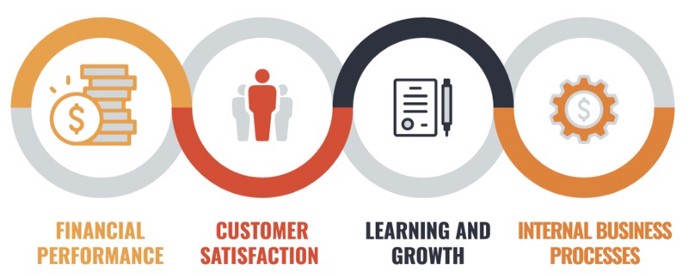Intro to KPIs for FinTechs
- Geoffrey Charles

- Jul 18, 2019
- 3 min read
Updated: Jul 18, 2019
Define your Balance Scorecard
Defining, tracking and reporting on Key Performance Indicators (KPIs) is a critical process to review the health of a business. One common method to do so is the Balanced Scorecard (BSC) which organizes KPIs across 4 focus areas:
1. Financial: How do our shareholders see us? This perspective views organizational financial performance and the use of financial resources.
2. Customer: How do our customers see us? This perspective views organizational performance from the point of view the customer or other key stakeholders that the organization is designed to serve.
3. Internal Processes: What must we excel at to satisfy our customers and shareholders (investors)? Views organizational performance through the lenses of the quality and efficiency related to our product or services or other key business processes.
4. Learning & Growth: How can we continue to improve (innovate) and create value? Views organizational performance through the lenses of human capital, infrastructure, technology, culture and other core competencies that are key to breakthrough performance.
Identify and track core metrics
The exact metrics for each of these 4 focus areas will differ based on your organization’s strategy, stage and sector. Here are a few examples of metrics we have tracked in Consumer Lending and FinTech:
1. Financial
Financial metrics tracked are directly tied to what investors care about when investing in a lending company. Here are a few metrics to measure the health of a lending portfolio:
* Net Present Value (NPV) / account — are you generating enough revenue on a per account basis?
* Customer Acquisition Cost (CAC) — are you acquiring customers at a low enough cost?* Operating Profit — are you profitable?
* Total balances outstanding — do you have a large lending portfolio?
* Net Yield — is capital invested generating enough returns?
* Net Adjusted Charge Offs (NACO) — are credit losses within expectations?
* Projected months of capital available — do you have enough capital to survive?
* Monthly growth — are you growing fast enough?
2. Customer
Customer metrics tracked are meant to determine if customers like your product and are are better off by using it. In many industries, healthy customer engagement is a major driver of valuation. Here are a few metrics to measure customer health:
* CSAT — are customers satisfied with your product?
* Ratings on 3rd party sites — are customers saying good things about your product?
* Activation rate — are customers activating their cards and using them?
* Voluntary attrition rate — are customers staying with you?
* Monthly active users — are customers continuously engaging with you?
* FICO score change — are your customers improving their credit score (compared to control group)?
* Financial Health (survey) — are you helping your customers improve their financial health (compared to control group)?
3. Internal Processes
Internal processes metrics capture whether the company will scale sustainably over time. The quality of systems and operations will make or break FinTech companies — time spent fixing, remediating and supporting is not being spent building new capabilities. And errors in a regulated environment are costly. Here are a few metrics to measure internal process health:
* System availability — are our systems maintaining quality as we scale?
* Operational costs / open account — can the resources dedicated to supporting operations scale?
* Number of high severity issue — do we have a low rate of issues ensuring our systems and processes are well implemented?
* Complaints / 10,000 customers — do we have low complaint rates and therefore managed compliance risk?
4. Learning & Growth
At the end of the day, a company is made of of people. Learning and growth metrics aim to measure human capital which is at the core of a company’s success. Here are a few metrics to measure learning & growth:
* Employee engagement score or other ratings (e.g. Glassdoor)— are employees engaged and fulfilled at work?
* Voluntary attrition — does your talent want to stay at your company?
* Referrals — do your employees vouch for your company as a good place to work?
* Open vacancies — can you attract talent fast enough?
Prioritize which metric to move
You cannot improve what you cannot track. Yet you do not need to improve everything you track either. Simply by tracking you will have invaluable information with which you can define future strategies.
Companies should have goals to move only a subset of the metrics in the balance scorecard. This depends on the company strategy which should factor in:
What is needed in the short term to remain in businessWhat will drive the most value for the company long termThe interaction between metrics (e.g. one metric having positive effects on many others).
The rule of thumb is that if you are trying to move all metrics, you will end up not improving anything at all. Prioritization and focus is key to execution. Any metric you are choosing to not focus on should still be monitored, reported and assessed. This will ensure you and everything in your company has visibility into the health of the business and the strategy going forward.








Comments